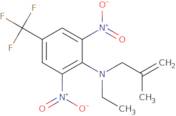Ethalfluralin
CAS: 55283-68-6
Ref. 3D-FE101475
| 1g | Discontinued | ||
| 50mg | Discontinued | ||
| 100mg | Discontinued | ||
| 250mg | Discontinued | ||
| 500mg | Discontinued |
Product Information
- (2,6-Dinitro-4-(trifluoromethyl)phenyl)ethyl(2-methylprop-2-enyl)amine
- 259-564-3
- Benzenamine, N-ethyl-N-(2-methyl-2-propen-1-yl)-2,6-dinitro-4-(trifluoromethyl)-
- Benzenamine, N-ethyl-N-(2-methyl-2-propenyl)-2,6-dinitro-4-(trifluoromethyl)-
- Buvilan
- El 161
- Ethafluralin
- Ethalfluraline
- N-Ethyl-N-(2-methyl-2-propen-1-yl)-2,6-dinitro-4-(trifluormethyl)anilin
- N-Ethyl-N-(2-methyl-2-propen-1-yl)-2,6-dinitro-4-(trifluoromethyl)aniline
- See more synonyms
- N-Ethyl-N-(2-methyl-2-propen-1-yl)-2,6-dinitro-4-(trifluoromethyl)benzenamine
- N-Ethyl-N-(2-methylprop-2-en-1-yl)-2,6-dinitro-4-(trifluormethyl)anilin
- N-Ethyl-N-(2-methylprop-2-en-1-yl)-2,6-dinitro-4-(trifluoromethyl)aniline
- Sonalan
Ethalfluralin is an herbicide that is used to control grasses and broad-leaved weeds in crops such as maize, wheat, and rice. It is a contact herbicide that inhibits the growth of plants by blocking photosynthesis. Ethalfluralin has been shown to have a negative effect on the production of antimicrobial peptides in the body, which may be due to its ability to bind to nuclear DNA and inhibit protein synthesis. It also inhibits carthamus tinctorius fatty acid metabolism, which might affect how well it can be absorbed into the body. There are no known carcinogenic effects associated with ethalfluralin exposure.





